Fair Start Scotland evaluation report 1: implementation and early delivery review
This Fair Start Scotland (FSS) evaluation report covers evaluation findings and data analysis relating to the implementation and early delivery of FSS employment support services in the first 6 months of delivery.
3. Reach of Fair Start Scotland Services: April – Sept 2018
Even when the labour market is relatively strong, research evidence[6] and labour market statistics show that people with disabilities and long term health conditions are more likely to encounter barriers to finding and sustaining employment. These barriers may arise from employers’ attitudes or limitations, or from individual circumstances, e.g. having a mental health condition or learning disability. Similarly, other individual characteristics and circumstances, such as poverty, substance misuse, criminal convictions and being poorly socially integrated, can also act as a barrier to finding work. These barriers are not mutually exclusive, and can make people more vulnerable to poor health, financial insecurity and long term unemployment.
A full list of the eligibility criteria for FSS is included in Appendix 1.
The following chapter shows how the demographic profile of those starting on FSS up to the end of September 2018 compared to the unemployed population in Scotland as a whole, using data from published employability statistics and the Annual Population Survey[7] (APS).
The sections look to address three key questions:
- Who started on FSS in the first 6 months?
- What barriers do participants encounter when seeking work?
- Who left the service early and why?
3.1 Who started on Fair Start Scotland in the first six months?
Between April – September 2018, 9789 individuals were referred to FSS, and of these people, 4978 (51%) individuals started on the service in the first six months[8].
How do Fair Start Scotland (FSS) participants compare to unemployed people in Scotland?
FSS starts (April-Sept 2018, SG) compared to Scottish unemployment data (Jan-Dec 2018, ONS)
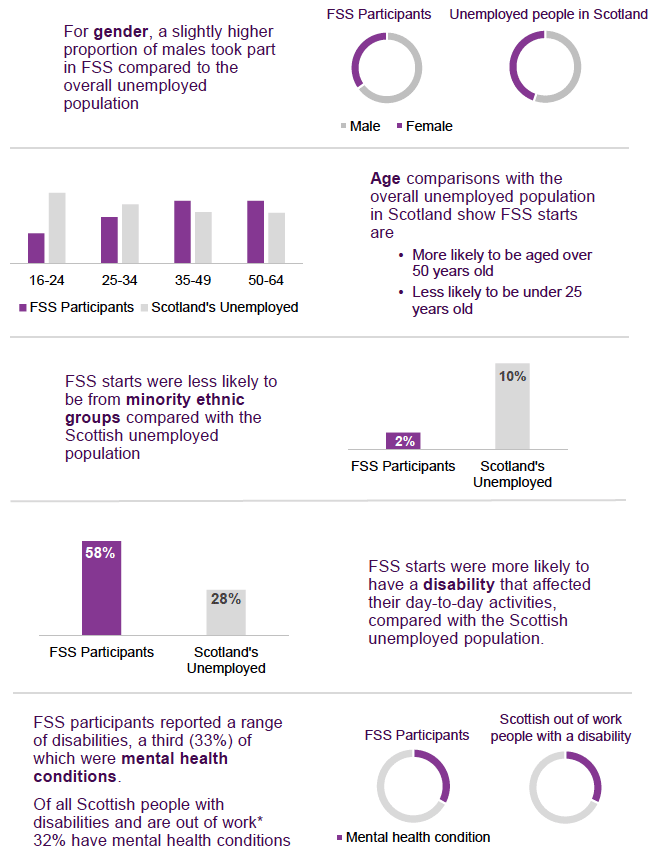
*Out of work refers to unemployment + economic activity. Disability employment data (Jan-Dec 2017, APS).
Age and gender
A higher proportion of men (64.4%) than women (34.7%) started on FSS services in the first six months, and this was consistent across all age groups. This suggests that there is a higher proportion of male participants within FSS, than in the unemployed population across Scotland, where 55% were male, and 45% were female.
Figure 1: Age groups of FSS participants compared to unemployed population in Scotland
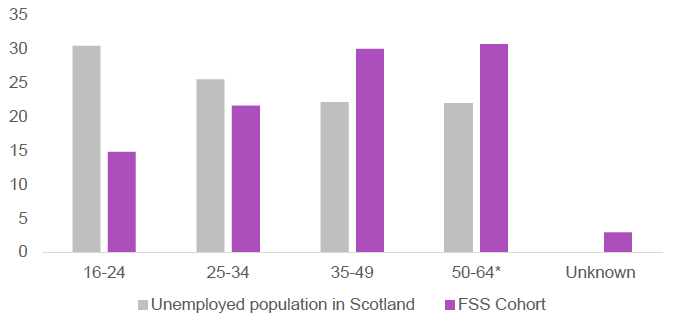
* For FSS, this group is aged 50-65+
As shown in Figure 1, a larger proportion of older people, and a smaller proportion of younger people took part in FSS compared to the equivalent proportions of each group in the Scottish unemployed population.
Ethnicity
In terms of self-reported ethnicity, 80.5% of FSS participants identified as white, and 2.3% from a minority ethnic background[9]. This is lower than the proportion of people from minority ethnic groups in the unemployed population overall.
Providing equalities monitoring information, including self-reported information on ethnicity is not compulsory for FSS participants, and some people choose not to share this information. We are working with FSS Service Providers to maximise collection of equalities characteristics for future publications, so that we can better understand how well services are reaching those who need them most.
3.2 What barriers do participants encounter when seeking work?
Disability and Health Conditions
Over two thirds (69%) of FSS participants reported having a long-term health condition. Mental health conditions were the most common, as reported by a third (33%) of participants (Figure 2). This was also the most prevalent health barrier reported by participants in earlier transitional employability services, WFS and WAS.[10]
Figure 2: Long-term health conditions reported by FSS Participants
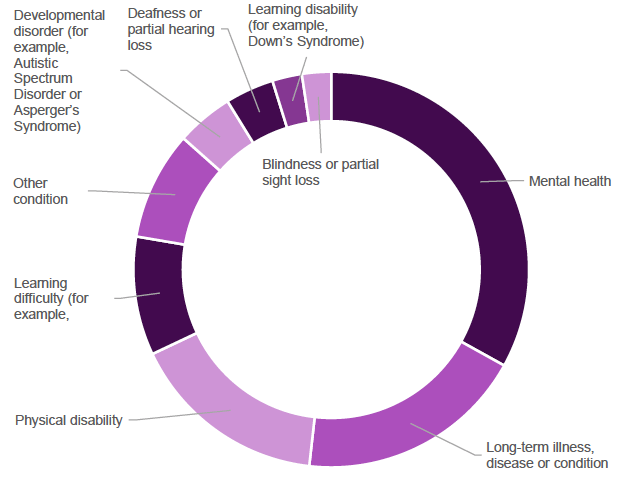
Of those who reported having a health condition, 85% reported that their ability to carry out day-to-day activities was either ‘limited a lot’ or ‘limited a little’ as a result. This means that over half (58%) of FSS participants reported having a disability[11].
Therefore, a larger proportion of FSS participants (58%) reported a disability compared to the proportion of disabled individuals in the unemployed population as a whole (28%). This is not unexpected, as individuals with disabilities are one of the main groups that FSS aims to support.
Living in areas of deprivation
People living in areas of deprivation may face barriers to finding and sustaining employment. APS data for January to December 2018 showed that 9% of those living in the 15% most deprived areas of Scotland reported being unemployed, compared to 4% of the Scottish population overall.
Individuals who live in the 15% most deprived areas in Scotland represent 26% of the unemployed population, and 37% of FSS participants.
Almost half (46%) of the FSS participants lived in the most deprived 20% of Scotland[12], and the distribution of participants was more strongly grouped in the most deprived areas, as shown in Figure 3.
Figure 3: Distribution of FSS participants by SIMD 2016 Quintiles
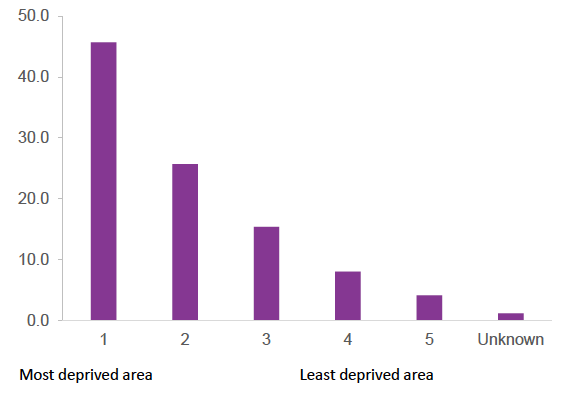
Urban and Rural areas
APS data shows that individuals from urban areas tend to have a higher rate of unemployment (5%) than those from rural areas (4%).
Within FSS, the majority of participants (91%) were from urban areas. Individuals from rural areas represent 15% of the unemployed population, and made up 8% of FSS participants.
3.3 Who left the service early and why?
Of the total number of starts between April and September 2018, 14% (685) of FSS participants left the service in the first 6 months without completing their pre-employment support period or moving into employment. We have some information on the range of reasons given for leaving services early and have provided some initial analysis on this below.
Reasons for leaving early
As shown in Figure 4, the majority (78%) of FSS participants leaving early had “disengaged” from the service. A small proportion of participants left to attend college, university, or further training (6% in total), or due to health-related issues (6%) or non-health related personal reasons (3%).
Figure 4: Reasons for leaving the service (FSS participants April-Sept 2018)
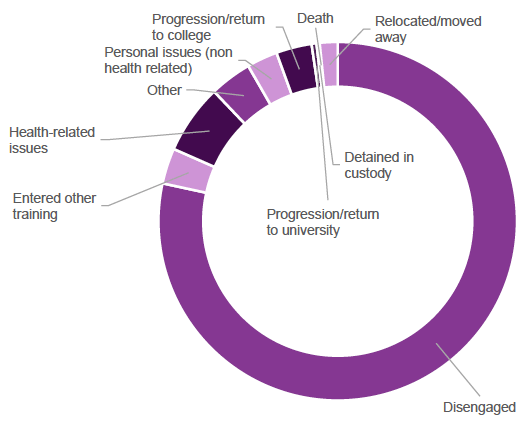
Early leavers by Age and Gender
As shown in Figure 5 below, older participants were more likely to leave the service early. The largest group of early leavers were aged between 50-65+ (31.5%), followed by those aged 35-49 (28%). Furthermore, as demonstrated in Figure 6, early leavers were more likely to be male (64%) than female (36%).
Figure 5: Age of Early Leavers
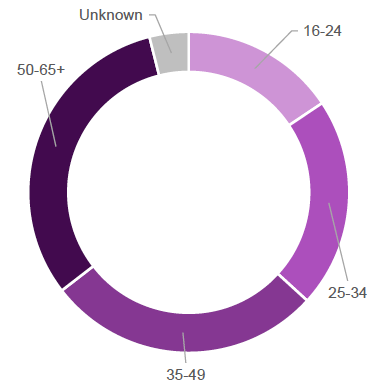
Figure 6: Gender of Early Leavers
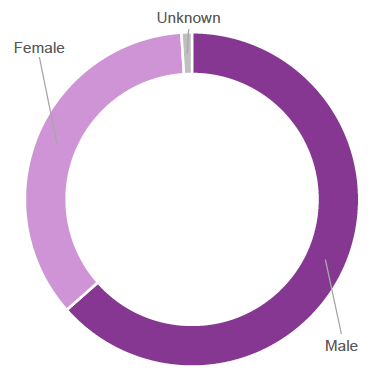
Conclusions
- The main groups under-represented across the first six months of service delivery are young people aged 16-25, women and those from minority ethnic groups.
- For young people, this could be partly due to the range of provision already in place to support people aged 16-25 in their journey towards and into work (e.g. Activity Agreements, Opportunities for All, Inspiring Scotland Fund).
- A more targeted approach to awareness and engagement may be required to encourage further participation by women and people from minority ethnic groups.
What is SG doing?
- SG is engaging with BAME stakeholder groups to identify actions to raise awareness of the service amongst BAME communities. This issue was discussed at a session on employability support as part of the SG hosted Race Equality Employment Summit on 21 March 2019.
- Young Parents (aged under 25 years) have been identified as being particularly vulnerable to ongoing unemployment and poverty and are a priority family group for the Tackling Child Poverty Delivery Plan[13]. We plan to gather more information in the coming year to help us identify participants with dependent children and report on their experience of FSS services and longer term outcomes.
- SG is reviewing its FSS Equalities Impact Assessment evidence in light of performance for the first year of service delivery (to March 2019). We will use current regional employment data to identify where FSS Service Providers could better engage with eligible participants s as part of our overall Continuous Improvement Plan.
- SG is also working with a range of stakeholder groups to identify and understand more on the needs of the FSS early entry groups, so that we can better support them. Our next evaluation publication will include a more detailed breakdown of participation across eligibility criteria, and the characteristics and barriers associated with early entry to FSS services. This could include comparisons and commentary on:
- Length of time unemployed for disabled individuals
- Participants who are ex-offenders or have convictions
- Care experienced young people
- Lone parents
- Benefits received by FSS participants
- Length of time unemployed
- Refugee status
- Qualifications
Contact
Email: Kirstie.Corbett@gov.scot
There is a problem
Thanks for your feedback